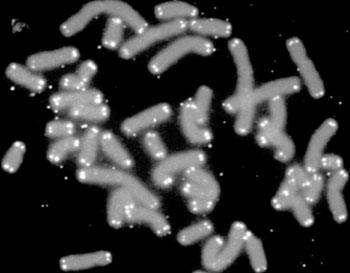Transplanted Blood Cell Biomarker Associated with Improved Survival
By LabMedica International staff writers
Posted on 23 Feb 2015
Among patients with severe aplastic anemia who received stem cell transplant from an unrelated donor, longer leukocyte telomere length, a structure at the end of a chromosome was associated with increased overall survival at five years.Posted on 23 Feb 2015
Aplastic anemia is a blood disorder where the bone marrow fails to make new blood cells, with one of the causes potentially being defects in telomere biology. Allogeneic or genetically different hematopoietic cell transplantation (HCT) is recommended as initial therapy for young patients with acquired severe aplastic anemia when a matched sibling donor is available.
A team of scientists led by those at the National Cancer Institute (National Institutes of Health, Rockville, MD, USA) evaluated the association between recipient and donor pretransplant leukocyte telomere length with outcomes after unrelated donor allogeneic HCT for 330 patients with severe aplastic anemia. Patients underwent HCT between 1989 and 2007 in 84 centers and were followed-up to March 2013. Leukocyte telomere length for both recipient and donor analyses was categorized based on the leukocyte telomere length tertiles in the donors: long (third tertile) and short (first and second tertiles combined).
The scientists used samples of peripheral blood mononuclear cells or whole blood collected, processed, and stored in liquid nitrogen or at -80 °C. They measured relative leukocyte telomere length in extracted DNA using monoplex quantitative real-time polymerase chain reaction (qPCR) performed on the Prism 7700 Sequence Detection System (Applied Biosytems; Foster City, CA, USA), a thermal cycler equipped to excite and read emissions from fluorescent molecules during each cycle of the PCR.
The investigators found that longer donor leukocyte telomere length was associated with a higher overall survival, 5-year overall survival was 56% versus 40% in the short donor leukocyte telomere length group. After adjusting for donor age and clinical factors associated with survival following HCT in severe aplastic anemia, the risk of post-HCT all-cause mortality remained approximately 40% lower in patients receiving HCT from donors with long versus short leukocyte telomere length. Similar patterns were observed by subtypes of the disease. There was no association between donor leukocyte telomere length and engraftment or graft-vs-host disease, a complication of bone marrow transplantation. Recipient telomere length was not associated with patient overall survival
The authors concluded that among patients with severe aplastic anemia who received unrelated donor allogeneic HCT, longer donor leukocyte telomere length was associated with increased overall survival at three and five years. This observational study suggests that donor leukocyte telomere length may have a role in long-term post-transplant survival. The study was published on February 10, 2015, in the Journal of the American Medical Association.
Related Links:
US National Cancer Institute
Applied Biosytems
















